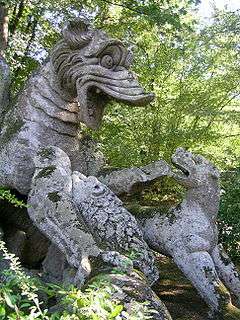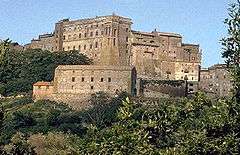Gardens of Bomarzo





Coordinates: 42°29′29.88″N 12°14′51.27″E / 42.4916333°N 12.2475750°E The Sacro Bosco ("Sacred Grove"),[1] colloquially called Park of the Monsters (Parco dei Mostri in Italian), also named Garden of Bomarzo, is a Manieristic monumental complex located in Bomarzo, in the province of Viterbo, in northern Lazio, Italy.[2]
The garden was created during the 16th century.[3] The garden is situated in a woods, located in a valley bottom, beneath the castle of Orsini, and populated by sculptures, and small buildings, located among the natural vegetation.
History
The park's name stems from the many larger-than-life sculptures, some sculpted in the bedrock, which populate this predominantly barren landscape. It is the work of Pier Francesco Orsini, called Vicino, a 16th century condottiero, and patron of the arts, greatly devoted to his wife Giulia Farnese (not to be confused with her maternal grandmother Giulia Farnese, the mistress of Pope Alexander VI). When Orsini's wife died, he created the gardens to cope with his grief. The design is attributed to Pirro Ligorio, and the sculptures to Simone Moschino.
During the 19th century, and deep into the 20th, the garden became overgrown and neglected, but after the Spanish painter Salvador Dalí made a short movie about the park, and completed a painting actually based on the park in the 1950s, the Bettini family implemented a restoration program which lasted throughout the 1970s, and today the garden, which remains private property, is a major tourist attraction.
Description
Style
The park of Bomarzo was intended not to please, but to astonish, and like many Mannerist works of art, its symbolism is arcane: examples are a large sculpture of one of Hannibal's war elephants, which mangles a Roman legionary, or the statue of Ceres lounging on the bare ground, with a vase of verdure perched on her head.
The many monstrous statues appear to be unconnected to any rational plan, and appear to have been strewn almost randomly about the area, sol per sfogare il Core ("just to set the heart free") as one inscription in the obelisks says.
Allusive verses in Italian by Annibal Caro (the first one is of him, in 1564), Bitussi, and Cristoforo Madruzzo, some of them now eroded, were inscribed beside the sculptures.
The reason for the layout and design of the garden is largely unknown : perhaps they were meant as a foil to the perfect symmetry and layout of the great Renaissance gardens nearby at Villa Farnese, and Villa Lante. Next to a formal exit gate is a tilting watchtower-like casina, the so-called Casa Pendente ("Leaning House").
Sculptures
- A fountain called Pegasus, the winged horse
- Two sirens, probably Proserpina, wife of Pluto
- Orcus with its mouth wide open and on whose upper lip it is inscribed "All Thoughts Fly", which is illustrated by the fact that the acoustics of the mouth mean that any whisper made inside is clearly heard by anyone standing at the base of the steps.
- A whale
- Two bears
- A dragon attacked by lions
- Proteus with weapons of Orsini
- Hannibal's elephant catching a Roman legionary
- Cerberus
- A turtle with a winged woman on its back
- A small theater of Nature
- A giant who brutally shreds a character
- A triton in a niche
- Two Ceres, sitting and standing
- A sleeping nymph
- Aphrodite
- The giant fruit, cones and basins
Monuments
- The Leaning House : dedicated to cardinal Cristoforo Madruzzo, who was a friend of Vicino Orsini and his wife.
- The Temple of Eternity : memorial to Giulia Farnese, located at the top of the garden, it is an octagonal building with a mixture of classical, Renaissance and Etruscan genres. It currently houses the tombs of Giovanni Bettini and Tina Severi, the owners who restored the garden in the twentieth century.
Legacy
- The surreal nature of the Parco dei Mostri appealed to Jean Cocteau and the great surrealist Salvador Dalí, who discussed it at great length.
- The poet André Pieyre de Mandiargues wrote an essay devoted to Bomarzo.
- Niki de Saint Phalle was inspired by Bomarzo for her Tarot Garden, Giardino dei Tarocchi.
- The story behind Bomarzo and the life of Pier Francesco Orsini are the subject of a novel by the Argentinian writer Manuel Mujica Láinez, Bomarzo (1962). Mujica Láinez himself wrote a libretto based on his novel, which was set to music by Alberto Ginastera (1967). The opera Bomarzo premièred in Washington in 1967, since the Argentine government had condemned it as sexually offensive.
- Some scenes from the 1985 Frankenstein film The Bride starring Sting and Jennifer Beals were shot amidst the statuary at the Garden.
- A fight scene in the 1985 film The Adventures of Hercules takes place here and the Orcus' mouth acts as an entrance to a cave.
- The Dutch magic-surrealist painter Carel Willink used several of the park's statue groups in his paintings, e.g. The Eternal Cry and Balance of Forces.
- A replica of the Orcus mouth appears as a major setpiece in the 1997 film The Relic.
- Orcus mouth appears in the 1964 Italian horror film Il castello dei morti vivi (also known as Castle of the Living Dead).
See also
References
- ↑ Matteo Vercelloni, Virgilio Vercelloni Inventing the Garden 2010 - Page 73 "The Sacro Bosco (Sacred Wood) of Bomarzo, in Lazio, is a mysterious park full of curiosities, and monsters, located in what may once have been a ... "
- ↑ Caroline Holmes Icons of garden design: 2001 - Page 38 "The Sacro Bosco, or 'sacred grove', takes the Renaissance passion for garden symbolism to a climax. It is a bizarre collection of statues and architectural follies in a wood close to the border between Umbria and Lazio."
- ↑ (French) Encarta Encyclopedia Encarta.msn.com Retrieved 27 June 2009
Sources
- (Italian) Publication on Bomarzo site
- (Italian) Publication on Bomarzo site - Images
- (French) Hella Haase, Les jardins de Bomarzo, Seuil, Paris 2000
- (German) Richtsfeld, Bruno J.: Der "Heilige Wald" von Bomarzo und sein "Höllenmaul". In: Metamorphosen. Arbeiten von Werner Engelmann und ethnographische Objekte im Vergleich. Herausgegeben von Werner Engelmann und Bruno J. Richtsfeld. München 1989, S. 18 - 36.
- (French) Jessie Sheeler, Le Jardin de Bomarzo - Une énigme de la Renaissance, Actes Sud, Arles 2007
- (Italian) Calvesi M., Gli incantesimi di Bomarzo. Il Sacro Bosco tra arte e letteratura, Milano, Bompiani, 2000
| Wikimedia Commons has media related to Parco dei Mostri (Bomarzo). |
External links
- The park of Monsters
- Photo Gallery and information about the Monster Park at Culture Discovery Vacations
- Gorgeous Grotesques, by Paula de la Cruz, GARDEN DESIGN, Nov/Dec 2009
- A photo-essay on the garden and its meaning by Lee van Laer, Poetry Editor, Parabola Magazine, 2013